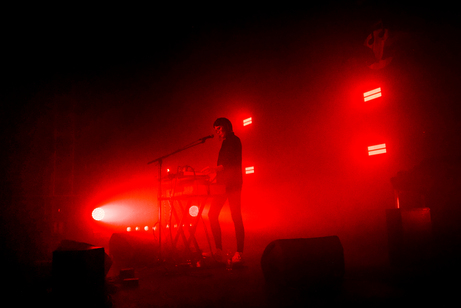Madlener House
4 West Burton Place
Chicago, Illinois 60610
Telephone: 312.787.4071
info@grahamfoundation.org

Tonight Whitney Johnson (aka Matchess) premieres Huizkol for viola, tuning forks and electronic instruments. The new work is an opportunity to engage with our own skepticism and belief in the effects of sound on the body.
Huizkol proceeds in seven small movements, or what Johnson calls “updrafts,” introducing sonic disequilibrium into the quad space of Madlener House. Low binaural sine waves rise and fall, tuning forks beat symmetrically (performed by forkists Kalina Malyszko and Havadine Stone), organ builds cluster chords, and tape-layered viola just intones. A VHS projection of colored light follows the same frequency arc as the sound.
Johnson finds inspiration and her title in the poetry of Anne Carson. She explains:
“In ‘The Wolf God,’ Carson consults with a community of women about the plight of lupine ears. Although wolves’ hearing is sharp enough to sense a cloud passing overhead, sometimes the wind will blow a seed into the aural canal. Losing equilibrium, mortal wolves go mad trying to stand upright; they die of anger. Only one—Huizkol—learned to survive disequilibrium.”
He took small steps at first.
Using the updrafts.
They called him Huizkol,
Whitney Johnson (b.1981, Clearfield, Penn.) is a musician, composer and writer living in Chicago. She performs with the viola, as well as combo organ, electronics and voice. As Matchess, she interprets the unknown with sound. Her techniques reproduce meaning through a range of historical material processes, including reel-to-reel tape looping, cassette tape sampling and field recording. In the Matchess Trilogy (2013-2018), Johnson used the limited palette of a 1960s Ace Tone combo organ, an analog Rhythm Ace drum machine, viola and voice to craft a sound collage of transient songs on a bed of ambient noise. She has recently collaborated in improvised and composed settings with Circuit des Yeux, TALsounds, Brett Naucke, Gel Set, Lia Kohl, Macie Stewart, Matt Jencik, Couteau Sang, Lea Bertucci and Sarah Davachi. In tandem with her music practice, she received her doctorate in the sociology of sound from the University of Chicago in 2018, writing a dissertation on the cultural value of embodied sensory perception, particularly in the discipline of sound art.
Whitney Johnson’s first Lampo appearance was in April 2018 with Sarah Davachi.
Since 2010 the Graham Foundation has supported and partnered with Lampo to produce this performance series held at the Madlener House. Lampo, founded in 1997, is a non-profit organization for experimental music and intermedia projects.
Artist Talk: Johnson discusses her new and recent works Huizkol (2020) and Fundamental 256 Hz (2019) and the limits of sound healing. She also reviews other examples of sound and its purported effects on the body. For instance, brainwave entrainment techniques claim to coax the mind into states of awareness through exposure to binaural beats. At the extreme, in 1936 American inventor Royal Raymond Rife maintained his beam ray clinical instruments would explode the “BX Virus Carcinoma” and other pathogens by producing resonant frequencies at their “Mortally Oscillating Rates.” Johnson extends the talk to her experience working at La Monte Young and Marian Zazeela’s Dream House in New York City. Lampo Annex, Monadnock Building, 53 W. Jackson Blvd. #1656. Friday, February 21, 6pm. RSVP HERE.
Image: Courtesy the artist. Photo: Alison Green
Copyright © 2008–2025 Graham Foundation. All rights reserved.